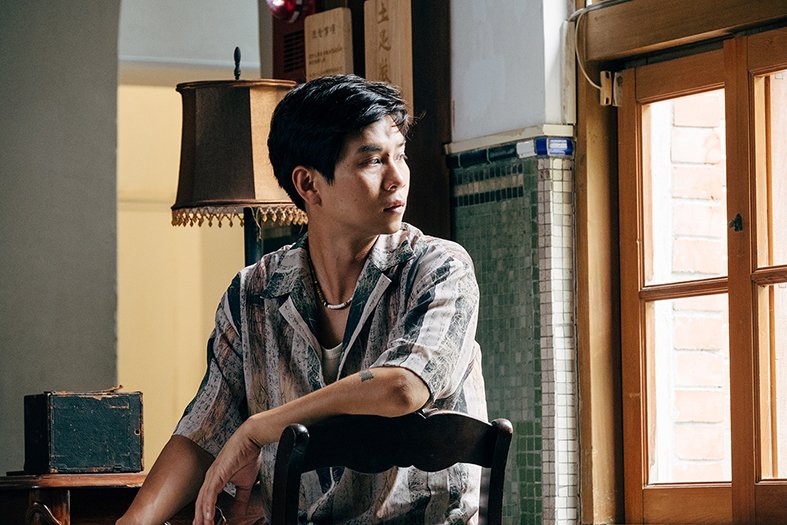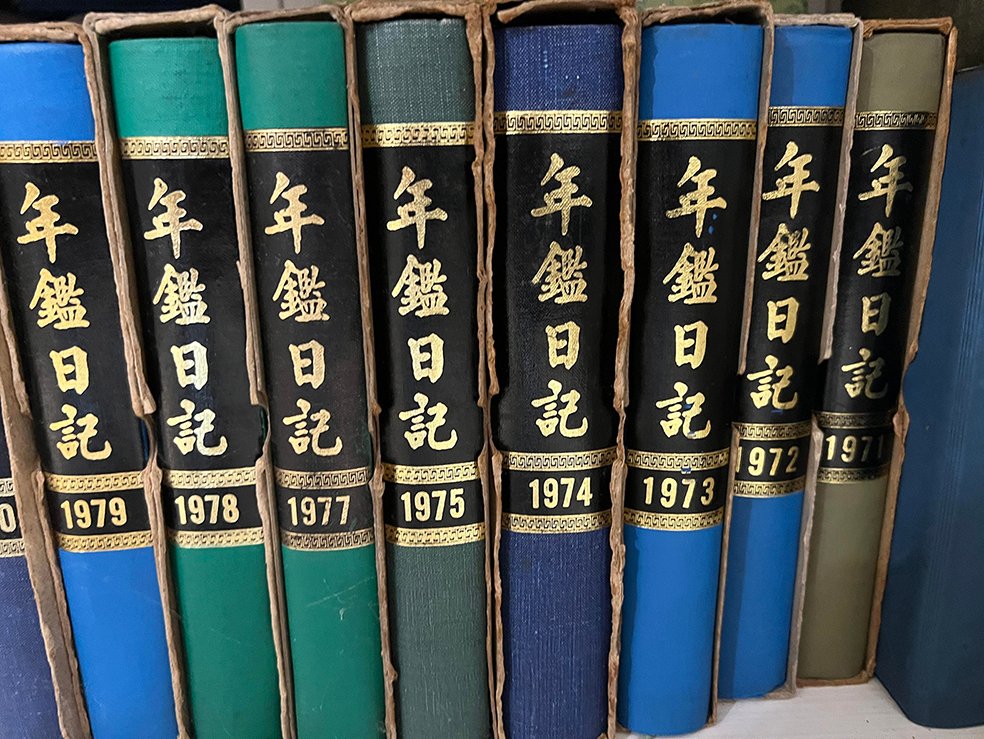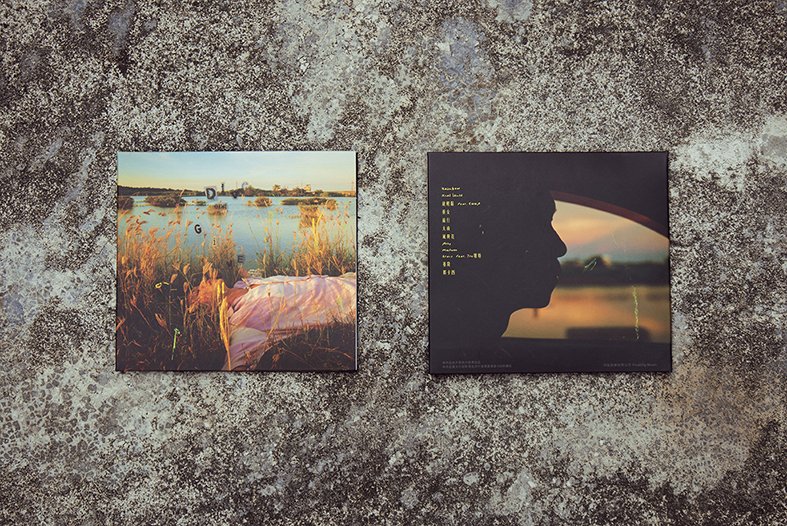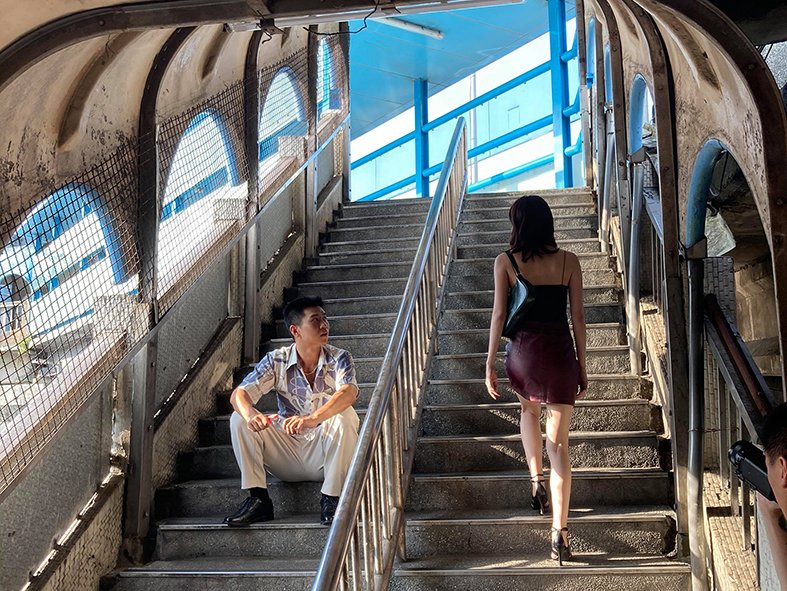A Musical Journey from Datun Mountain
Text - Yu Ju-Ling(游如伶)
Photography - Tsai Yao-Cheng(蔡耀徵)
The Aura of Musician L8ching

Photo: Singer-songwriter L8ching
L8ching appeared in a Hawaiian shirt, with black text covering the shirt taken from his grandfather’s diary. L8ching's grandfather was the military officer who came to Taiwan with the Nationalist Government; he first settled in a military housing village at the foot of Datun Mountain in Beitou. In the early 1970s, he moved and settled into an official residence on the mountain. Born in 1992, L8ching was born into a lineage of military officers, but he had never met his grandfather who liked to write calligraphy and cultivate flowers when he was alive. It was not until four or five years ago, when his old family home in Beitou was being renovated, that he found some diaries left by his grandfather when assisting his grandmother with opening a closed cabinet. One page per day, one book per year. With slick handwriting, His grandfather carefully described daily life and the journeys he went on. Aside from being a yearbook documenting L8ching’s family history, it bore record to appearances of various locations in Taiwan during the 1960s to the 1970s.
Flipping through the family records in his grandfather's diary, as if L8ching was talking to his grandfather across time and space. This row of thick yearbooks also inspired him creatively, “I followed my grandfather's handwriting and my grandmother's memories, and went back to Taiwan in the past. It was very touching, and it also made me want to record contemporary Taiwan, as well as my own feelings and thoughts, with my music.”

Photo: The diaries of L8ching’s grandfather recorded Taiwan from the 1960s to the 1970s. (Photo Courtesy: L8ching)
Family Bonds in Songwriting
L8ching released his first full length album “Dive & Give” last year, which was nominated for Best New Artist Award at the 33rd Golden Melody Awards. On the album, every track drew inspiration from personal experiences and reflected on the emotional bonds between family. This was not only his first album, but also the first volume in a chronicle of his personal life’s journey.
When creating “Dive & Give”, L8ching began exploring both the story of Taiwan's land and his own personal growth. Once his father learned about his endeavor, he was handed three tapes. The tapes were like a time machine, containing soundscapes from when he was just born and taken back to the family house in Datun Mountain: the crying and babbling of baby L8ching, the, chatting at the dining table and the interaction between parents and children, etc. “When listened to these sounds when I was in my creative process, I felt very warm and safe, as if I was at home. Thus, I decided to put these sounds into the track ‘Stars’”
At the time of writing this album, the epidemic meant he and his brother who was far away in Australia could not see each other. Writing “Stars” was L8ching’s way to send blessings and longings to his family from afar. In the track, ?te provides guest vocals and hums and recites the name of L8ching’s younger brother “Lei Chi”. The babbling of the prelude and the cry of the baby at the end of the song are all from the tape dating back to 1992, while the trumpet is used as a metaphor for the crying sound of the two brothers. The intertwined composition of music and tears are sung as the ties between the family.

Photo: L8ching's first full-length album “Dive & Give”. L8ching finds creative inspiration from Taiwanese culture and life experience, while his music also being a record of his personal life journey. (Photo courtesy: 浮氣音樂)
Imagining Beitou’s Music Culture through “Nakashi”
Aside from expressing his deep feelings for his family, L8ching also looks at the disappearing Beitou culture from a creative perspective. The theme of Nakashi was inspired by the once popular music performances of hostess clubs. When L8ching was growing up, the hostesses and traveling artists in the various establishments had all but disappeared. “As a child, my family often traveled to a hot spring restaurant in Liu Ku to eat and bathe in the hot springs. When entering the restaurant, the first thing you saw was the stage. I have, however, never seen the real Nakashi playing Beitou in person, and could only hunt for clues of its decline.”
The inspiration for creating “Nakashi” comes from the imagination of the old times and personal experiences. When L8ching was a university student, he sang at a bar in Suao, Yilan. The atmosphere of the bar at one o'clock in the night reminded him of Nakashi. “Musicians like to share music with those who need it, and those who drink need music. I sang on the stage to fishermen who had just docked at the harbor. Most of the hostesses were old friends or acquaintances. There was nothing horny in the atmosphere, instead having a very human touch.”
In the 2010s, while he was attending college, Beitou also transformed itself into a tourist area with a focus on its hot springs. This transformation also led to a boom in the area's cultural sector, with events such as the Taiwan Yueqin Folk Music Festival, the opening of the restored Xinbeitou Historic Station, and a wave of musicians and artists beginning to create music in their native language. Also influenced by this, L8ching and friends formed Arkmenband to attempt to interpret Taiwan's land and culture through their music. The band also received praise for their entry to the creative division of the South Music contest. This also led to L8ching finding a contract with famed folk musician Chen Ming-Chang's studio. Chen Ming-Chang would soon teach L8ching about the musical cultural landscape of Beitou; he was also introduced to a legend of Nakashi, Zhong Cheng-Da. “Cheng-Da's father had managed a big TV band. Wanting his son Zhong Cheng-Da to also become an artist, he would tell his son to go to perform Nakashi in Beitou to hone his skills. Though I never experienced that era, growing up in Beitou to become a musician, I feel a longing and yearning about those days.”
“Walking on Wenquan road one night, the scenery of the rainy mountain road, with wooden Japanese buildings and old-fashioned telephone poles made me feel like returning to Beitou in a certain time and space, and the melody of ‘Nakashi’ was born in my mind. My creative output begins with imagery. For me, music is a way that I can create an imaginary world.” Constructing the details of his tracks through field research, he imagined a story of a Nakashi's musician and a hostess falling in love, with ambient sounds that made the song even more life-like to listeners. In this track, he created an imaginary space similar to a movie or theater, while also expressing the magnificence and desolation of Nakashi music.
Nakashi and Beitou
“Nakashi” originated from Japan and is transliterated from the Japanese word “流し”, or flow. It is known for its “flow” like nature, often with musicians being on the move while playing. In the 1960s to the 1970s, the popularity of hot spring hotels and restaurants in Beitou led to an increased demand for Nakashi performances. In the early days, musicians would often play instruments and also sing. In the early days, musicians played and sang by themselves. It later evolved into a band of three to five people, using guitars, drums and accordions, or even an electronic organ with many sound effects, they took requests and also provided accompaniment for guests that wished to sing. In addition to singing in the hot spring hotel and restaurants, Nakashi bands would also go to different hotels and booths throughout the night. Beginning with abolition of prostitution in 1979, hot spring hotels and restaurants in the area began to fall out of favor. By the 1990s, new entertainment types such as karaoke and KTVs had emerged, furthering the gradual decline of Nakashi. Today, due to the disappearance of the conditions of minstrelsy artists, this type of music all but disappeared.

Photo: MV still of L8ching's “Nakashi” . (Photo courtesy: 浮氣音樂)

Photo: Beitou’s Wenquan Road has witnessed how the hot spring town has changed from the past to present.
The Scent of Hot Spring Sulfur in Music
Old-fashioned hot spring restaurants located in Yangmingshan, such as Liu Grotto Hot Spring Restaurant, Nature Hot Spring Restaurant, Manger Flower Art Village and Bayan Hot Spring Club, are all part of L8ching's family memory map. “Every time there was a family birthday or occasion, we would go to a hot spring restaurant to eat. The adults go to the hot springs after dinner, and children would play in the garden outside the restaurant. This is my childhood. Growing up in Beitou was very happy for me, because it allowed for a close relationship with nature.” In recent years, he has gotten into the habit of visiting wild hot spring in Yangmingshan mountains, which allows him to also explore the heat source in the unknown of the smoky and overgrown grass, while enjoying a unique sensory experience only wild hot springs can provide. One can feel both the icy water of the streams and the warm hot springs simultaneously. Finding artistic inspiration while listening to music in the secret realm of wild hot springs is another reason why he loves visiting such places.
“Beitou is my home. Its atmosphere has a very simple, mild and layback feeling, full of the human touch to it. I hope to express these emotions through my artistic output, as people of my generation will have our own interpretation of Beitou.” L8ching thought about the musicians from different generations who resided in Beitou, mentioning that the sulfur gas in the air easily damages instruments. It makes Beitou less suitable for piano players, though he did have another romantic take on this situation: “Maybe this is the musical tone of Beitou. Maybe the sulfur from the hot springs has caused all the recording equipment to be faulty, with the guitars and drums rusting, giving the music played here a unique tone of Beitou.”
